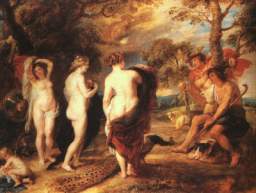
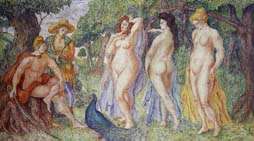


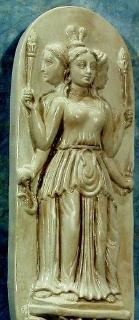
Hecate
[Metropolitan Museum of Art, New York City] White marble
colored Gypsumstone
Greek mythology presents to us the most ancients divinities as three women, triads of goddesses and phallic monsters.
The Moires, Moirai, "The Three Fates". The European word for the name 'Mary', which is not, as wrongly assumed, from the Hebrew name Miriam.
Indeed, in the Gospels, a product of Western civilization, there are Three Maries.
They were the Greek Fates. According to Hesiod, the daughters of Zeus and Themis. They were Atropos (the unbending, or the inevitable),Clotho (the spinner), and Lachesis (the caster of lots). As determiners of fate, they had supremacy even over the gods. Clotho spun out the thread of life, Lachesis determined its length, and Atropos cut it, resulting in death. The tale of Briar Rose - The Sleeping Beauty - who befalls to her sleep - death while she is spinning a thread, which is an obvious symbol of the penis, retraces the same pattern: A virgin manipulating her own penis, and the close association with Death.
Moira means Greek divine personification of fate, to whom even the gods were subject. Latin Fata, which came to mean Fairy.
Three is a complete penis.
If a Fairy comes alone, she will hold a magic stick as an alternative penis.
Can we imagine a sole fairy without a magic stick? Something will be indeed missing.
If they come in triads, they dont need a stick because their very number represents the missing member.
Hesiod gives the Greek Moirae as Atropos, Clotho and Lachesis ( Theogony, 905-6). Their Roman counterparts were Decima, Nona (goddesses of birth) and Morta (goddess of death).
The Erinnyes were "the Angry Ones", known as the Furies in Roman. They were the feared avenging goddesses in Greek and Roman mythology who were born from the falling drops of blood of Uranus (Sky) when he was mutilated by his son, the Titan Cronus. The drops fell on Mother Earth (Gaea) and impregnated her.
"...and Cronus cut off his father's genitals and threw them into the sea; and from the drops of the flowing blood were born Furies, to wit, Alecto, Tisiphone, and Megaera."
(Apollodorus, Library and Epitome)
Other versions of their birth claim that they were the daughters of Mother Earth and Darkness, or of Nyx (Night), or the Titans Cronus and Eurynome (and thus sisters to the Moerae, the Fates). One of their famous victims, Orestes, gave them the name 'Eumenides', the 'Solemn Ones', or 'Kindly Ones'.
Their home was at the entrance to Tartarus, that infernal place deep in the Underworld where the souls of the condemned were exiled, a gloomy place in Hades as far distant from earth as earth is distant from the sky. Others call their home Erebus, the darkest pit of the Underworld. There, the Erinnyes would screen out those unfortunate doomed who had yet to atone for their sins, relentlessly tormenting them.
No prayer, no sacrifice, and no tears could move them, or protect the hapless object of their persecution; and if ever they felt that the criminal would escape them, they called in the assistance of the goddess Dike (Justice). The Erinnyes were closely connected to Dike, for the merciless maintenance of strict justice was their utmost concern.
Often they were depicted as repulsive winged female creatures wearing black robes. Other descriptions adorned them with snakes twined in their hair, piercing red eyes dripping blood, pitch-black bodies with bat wings, and even sporting the heads of dogs.
In works of art and on the stage, however, their fearful appearance was greatly softened down, and they were represented as solemn and purposeful maidens, wearing the richly adorned attire of huntresses, with a band of serpents around their heads, and serpents or torches in their hands (For the serpent as a symbol of the female missing penis, cf. Why Is the Lady so Sexy? and Caravaggio and La Madonna del serpente).
Because nobody really wanted anything to do with these avenging creatures, mortals rarely referred to the Erinnyes by name, in case they invoked their wrath. Instead they were often euphemistically called the aforementioned Eumenides, the 'Kindly Ones' or 'Solemn Ones', the term coined by their hapless victim called Orestes.
Quite often they were depicted as a large flock of flying creatures, with the three named members leading the avenging pack.
Portrayed with and without wings, the Erinnyes in time became better known as those responsible for avenging offenses by children against their mothers, and not casually, because the erotic aggressive drive of the child is indeed firstly directed toward the mother.
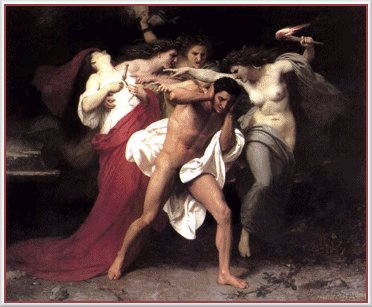
The Harpies, another triad of phallic monsters, who were filthy, monstrous, vulture-like female beasts loathed by humans, often served the Erinnyes in capturing or tormenting those unfortunate people who had displeased them.
The Harpies were creatures who had characteristics of a bird and a woman, similar to that of the Sirens. The Harpies had long claws and sharp beaks and could fly as fast as a bolt of lightening. Their names were Aello, Ocypete, and Celaeno; each as vicious as the other. They were also referred to as "robbers," "snatchers," and "those who seize," meaning that they would steel anything that did not belong to them.
Three were the Gorgons , virgins phallic monsters, as the Erynnies and the Harpies, and like them purely terrifying.
So frightening were the Gorgons that even other evil beings fled from the face of Medusa, the most famous of them, so the Greeks used flat images of Gorgons' faces for protection.
They are connected with Athene, for there is a myth about it, and Athene has Medusa's head on her chest. Medusa's head is an apotropaic (mean of defense) against genital penetration. Persephone too, the other virgin goddess, used it to scare away uncalled visitors.
Only one Gorgon was ever killed by a male hero -- Medusa herself. And not casually she was also the only one who lost her virginity, having been raped by Poseidon.
The other two were immortal and could not be killed at all.
Therefore, losing virginity, i.e., the virginal penis, and dismemberig from the number three, meant death.
The three Graiae sisters, themselves sisters of the Gorgons, always stay together because they have only one eye and one tooth to share among themselves.
As Freud and Abraham have shown, the eye and the tooth are a phallic symbol.
Therefore one eye is one penis, and one tooth is the same.
Again, three women = one penis.
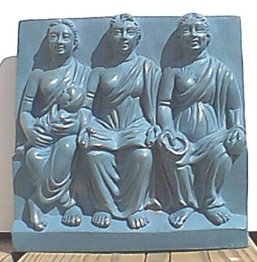
The Celtic Matronae are an elaboration of the Mediterranean nursing goddess Iono Lucine. This threefold image shows the Mothers holding Baby, napkins, and bath sponge. Throughout Celtic Gaul, Spain, and Britain this Iono depiction was deeply revered by the peasantry. This image, dating from perhaps 100 AD, is from the Vertault region in France.
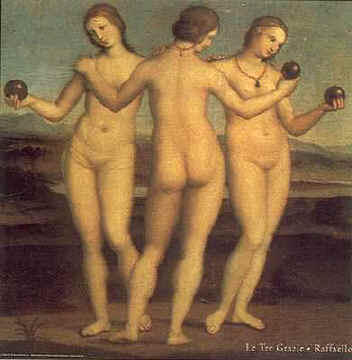
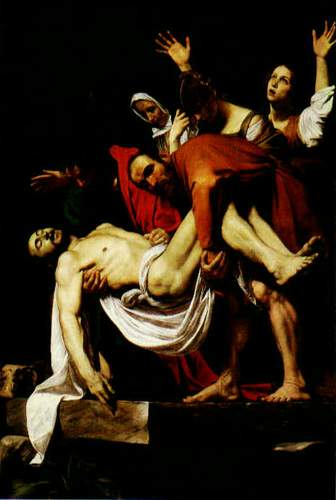
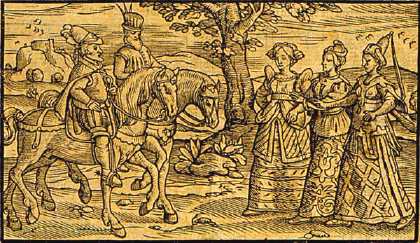

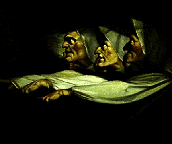


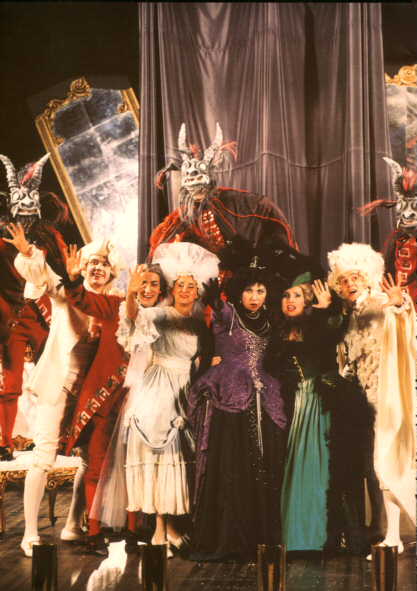
We might argue that what is represented here are the three inevitable relations that a man has with a woman—the woman who bears him, the woman who is his mate and the woman who destroys him; or that they are the three forms taken by the figure of the mother in the course of a man’s life—the mother herself, the beloved one who is chosen after her patterns, and lastly the Mother Earth who receives him once more. But it is in vain that an old man yearns for the love of woman as he had it first from his mother; the third of the Fates alone, the silent God-dess of Death, will take him into her arms (op.cit.).However, it seems to me that the argument is a rationalization, an abstract overlay on the concrete material from the deeper layers of our unconscious. The choice of Death is not the choice of the inevitable, but the product of an instinctual drive (Trieb), which is penetrating - castrating the female. In our unconscious, the genital sadistic instinct of penetrating - castrating the female translates into fantasies of death. The death of the female, and subsequently also the inevitable retaliation, which translates in our own death ( Lex Talionis).
See: Marino Marini and �The Coachmaker�s Three Daughters� (Le tre figlie del carrozziere)
Marino Marini: Scenario

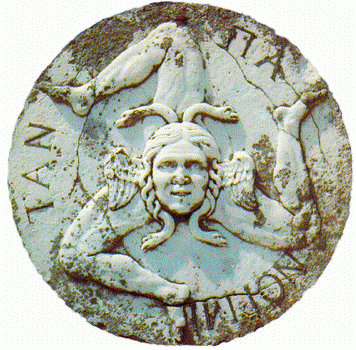
I should like, however, to devote a few words to one symbol, which , as it were, falls outside this class -- the number 3. Whether this number owes its sacred character to this symbolic connection remains undecided. But what seems certain is that a number of tripartite things that occur in nature- the clover leaf, for instance - owe their use for coats of arms and emblems to this symbolic meaning. Similarly, the tripartite lily - the so called fleur de lis and the remarkable heraldic device of two islands so far apart as Sicily and the Isle of Man - the triskeles (three bent legs radiating from a center) - seem to be the stylized versions of the male genitals(S.Freud,"Symbolism in Dreams", in op.cit., pp.163-4).

It is very interesting to notice that whereas three women are represented naked, at least one of them is shown with her back turned to the spectator, concealing her genital and exposing her buttocks to the viewer�s glance.
...And riding three women, Columbus discovered America: La Nina, La Pinta y la Santa Maria.
Postscript
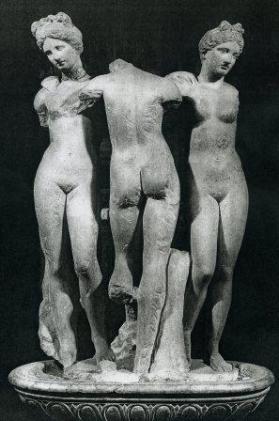
The Three Graces (A Roman sculpture dating to the first century A.D.) (Kolo Moser: Three Women - 1914)
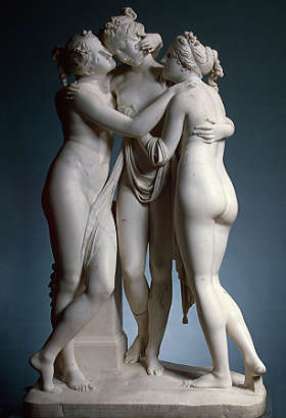

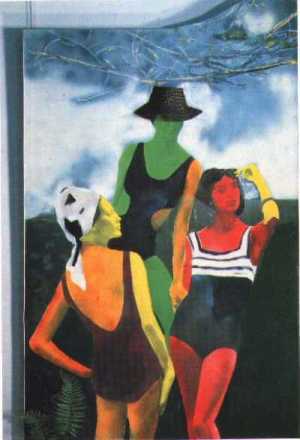
Canova in S. Petroburg Gaugin
Martial Raysse
In Gaugin's painting we can see that even if the three women are not naked, the painter's unconscious intention was of displaying them in a tri - dimensional position. In this work of art, too, the repressed malaise emerges to the surface. The same is true for Pop artist Martial Raysse in his Paysage Champ�tre en Quinze Tons (1963).
On the migration and displacement of the fantasized femal penis to the rear, and then to the tress, see: Rapunzel and Other Stories of Beautiful Hair
Botticelli's Primavera
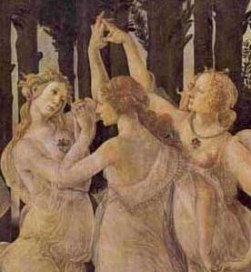
Zero sum
In the famous Renaissance painting, we can see that the Three Graces make with their hands the symbol of the female genital. The meaning is clear: we are three, therefore we are a penis. Henceforth there is a penis in our genital. This artistic representation is equivalent to the dream of one of Abraham's patients. The patient dreamed of a spider with a thread, and Abraham interpreted the patient's dream as the representation of a female genital (the spider) with a penis (the thread) ("The Spider as a Dream Symbol" (1922), in Selected Papers of Karl Abraham, Hogarth Press, London 1927, pp. 326-332).
In the advertising's representation we see the same unconscious meaning: We are zero, namely a female genital, which is rounded (like a Zero) and which is lacking (like Zero). However we are three, namely we are a penis. The representation condenses the same message.
Links:
Caravaggio and the Deposizione nel sepolcro
Duccio and La Madonna dei Francescani
Caravaggio, Clitorectomy and the Talion of the Woman
Caravaggio and La Madonna del serpente
Truth Is a Woman: Bernini - Giorgione - Manet
Medusa, the Female Genital and the Nazis
Mikis Theodorakis, Anti - Semitism, and Castration Anxiety
The Three Little Pigs and Bruno Bettelheim. How not to Make an Interpretation
Cinderella and "The Puss with the Boots"